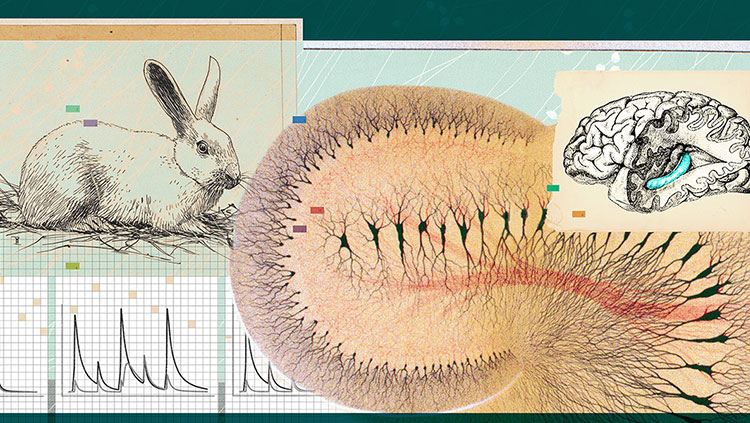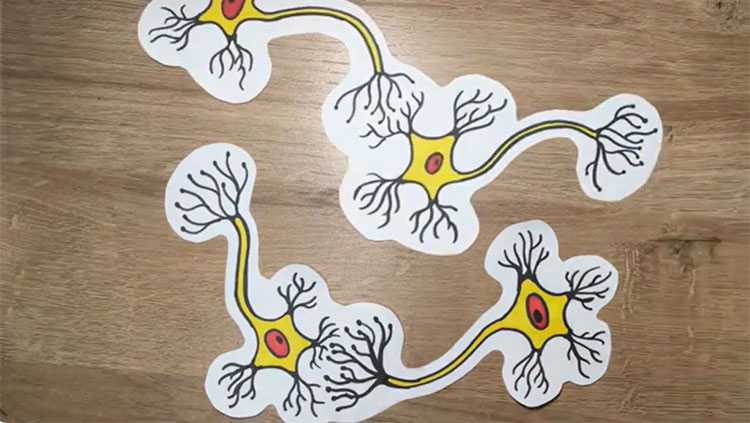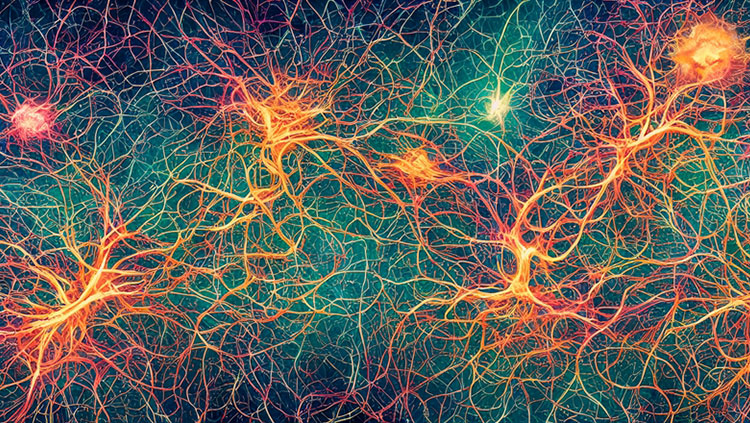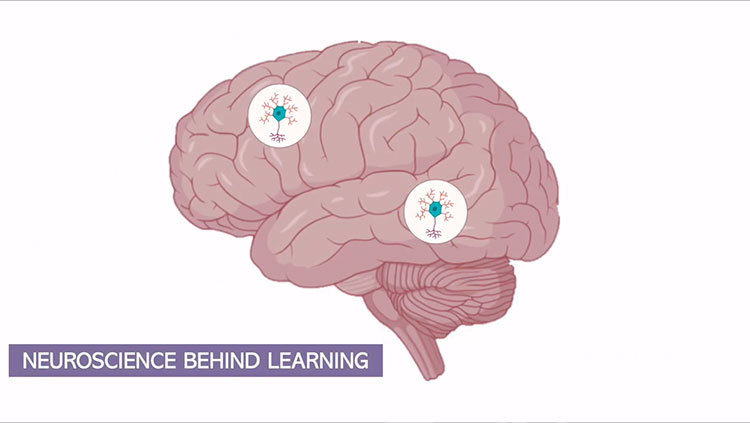Deriving Meaning from Specialized and Organized Brain Regions
- Reviewed24 Apr 2023
- Author Marissa Fessenden
- Source BrainFacts/SfN

How do we assign meaning to the faces we see, or the words we hear? We derive larger meaning from our sensory experiences as specialized brain regions work together. And if there is damage to a specialized region, we may have a harder time figuring out the meaning of the world around us.
For example, damage to certain areas of the temporal lobes leads to problems with recognizing and identifying visual stimuli. This condition, called agnosia, occurs in several forms and can impact one or more of our senses, depending on the exact location of the brain damage.
One specialized region helping us construct meaning from sight is the fusiform face area (FFA). Located on the underside of the temporal lobe, the FFA is critical for recognizing faces. This distinct area responds more strongly to images with faces than those without, and bilateral damage to this area results in prosopagnosia or “face blindness.” Similarly, a nearby region called the parahippocampal place area responds to specific locations, such as pictures of buildings or particular scenes. Other areas are activated only by viewing certain inanimate objects, body parts, or sequences of letters.
Within these brain areas, information is organized into hierarchies, as complex skills and representations are built up by integrating information from simpler inputs. One example of this organization is the way the brain represents words. Regions that encode words include the posterior parietal cortex, parts of the temporal lobe, and regions in the prefrontal cortex (PFC). Together, these areas form the semantic system, a constellation that responds more strongly to words than to other sounds, and even more strongly to natural speech than to artificially garbled speech. The semantic system occupies a significant portion of the human brain, especially compared to the brains of other primates. This difference might help explain humans’ unique ability to use language.
Separate areas within this system encode representations of concrete or abstract concepts, action verbs, or social information. Words related to each other, such as “month” and “week,” tend to activate the same areas, whereas unrelated words, such as “month” and “tall,” are processed in separate areas of the brain. Many studies using a technique called functional magnetic resonance imaging (fMRI) to measure brain activity in response to words have found more extensive activation in the left hemisphere, compared to the right hemisphere. However, when words are presented in a narrative or other context, they elicit fMRI activity on both sides of the brain.
Written language involves additional brain areas. The visual word form area (VWFA) in the fusiform gyrus recognizes written letters and words — a finding that is remarkably consistent across speakers of different languages. Studies of the VWFA reveal connections between it and the brain areas that process visual information, bridges that help the brain link meaning to written language. Likewise, there are specific brain areas that represent numbers and their meaning. These concepts are represented in the parietal cortex with input from the occipitotemporal cortex, a region that participates in visual recognition and reading. These regions work together to identify the shape of a written number or symbol and connect it to its concept, which can be broad. For example, the number “3” is applied to sets of objects, the concept of trios, or the rhythm of a waltz.
Thus, through constructing hierarchical, connected representations of concepts, the brain is able to build meaning. All of these skills depend on the fluid and efficient retrieval and manipulation of semantic knowledge.
Adapted from the 8th edition of Brain Facts by Marissa Fessenden.
CONTENT PROVIDED BY
BrainFacts/SfN
References
Anaki, D., Kaufman, Y., Freedman, M., & Moscovitch, M. (2007). Associative (prosop)agnosia without (apparent) perceptual deficits: a case-study. Neuropsychologia, 45(8), 1658–1671. https://doi.org/10.1016/j.neuropsychologia.2007.01.003
Barense M. D., Warren. J. D., Bussey, T. J., Saksida, L. M. (2016) Oxford Textbook of Cognitive Neurology & Dementia, Chapter 4: The temporal lobes. https://academic.oup.com/book/24555/chapter-abstract/187755187?redirectedFrom=fulltext
Best, J. R., & Miller, P. H. (2010). A developmental perspective on executive function. Child development, 81(6), 1641–1660. https://doi.org/10.1111/j.1467-8624.2010.01499.x
Binder, J. R., Desai, R. H., Graves, W. W., & Conant, L. L. (2009). Where is the semantic system? A critical review and meta-analysis of 120 functional neuroimaging studies. Cerebral cortex (New York, N.Y.: 1991), 19(12), 2767–2796. https://doi.org/10.1093/cercor/bhp055
Florence Bouhali, F., Thiebaut de Schotten, M., Pinel, P., Poupon, C., Mangin, J. F., Dehaen, S., & Cohen, L. (2014). Anatomical Connections of the Visual Word Form Area. Journal of Neuroscience, 34(46) 15402-15414. https://doi.org/10.1523/JNEUROSCI.4918-13.2014
Buchsbaum, B. R., Hickok, G., Humphries, C. (2001). Role of left posterior superior temporal gyrus in phonological processing for speech perception and production. Cognitive Sci, 25, 663-678. http://www.sciencedirect.com/science/article/pii/S0364021301000489
Campbell, M. E., & Cunnington, R. (2017). More than an imitation game: Top-down modulation of the human mirror system. Neuroscience and Biobehavioral Reviews, 75, 195–202. https://doi.org/10.1016/j.neubiorev.2017.01.035
Centelles, L., Assaiante, C., Nazarian, B., Anton, J. L., & Schmitz, C. (2011). Recruitment of both the mirror and the mentalizing networks when observing social interactions depicted by point-lights: a neuroimaging study. PloS One, 6(1), e15749.https://doi.org/10.1371/journal.pone.0015749
Charpentier, C. J., De Neve, J. E., Li, X., Roiser, J. P., & Sharot, T. (2016). Models of Affective Decision Making: How Do Feelings Predict Choice? Psychological Science, 27(6), 763–775. https://doi.org/10.1177/0956797616634654
Dixon, M. L., & Christoff, K. (2014). The lateral prefrontal cortex and complex value-based learning and decision making. Neuroscience and Biobehavioral Reviews, 45, 9–18. https://doi.org/10.1016/j.neubiorev.2014.04.011
Domanski C. W. (2013). Mysterious "Monsieur Leborgne": The mystery of the famous patient in the history of neuropsychology is explained. Journal of the History of the Neurosciences, 22(1), 47–52. https://doi.org/10.1080/0964704X.2012.667528
Domenech, P. & Koechlin, E. (2014). Executive control and decision-making in the prefrontal cortex. Curr Opin Behav Sci, 1, 101-106.
http://www.sciencedirect.com/science/article/pii/S2352154614000278
Doré, B. P., Zerubavel, N., Ochsner, K. N. (2015). Social cognitive neuroscience: A review of core systems. In Mikulincer, M., Shaver, P. R., Borgida, E., & Bargh, J. A. (Eds.), APA Handbook of Personality and Social Psychology, Vol. 1. Attitudes and social cognition (pp. 693–720). American Psychological Association. https://doi.org/10.1037/14341-022
Frederick R. (2014). Testing for executive function in gibbons. Proceedings of the National Academy of Sciences of the United States of America, 111(13), 4738. https://doi.org/10.1073/pnas.1401589111
Hickok G. (2009). The functional neuroanatomy of language. Physics of Life Reviews, 6(3), 121–143. https://doi.org/10.1016/j.plrev.2009.06.001
Huth, A. G., de Heer, W. A., Griffiths, T. L., Theunissen, F. E., & Gallant, J. L. (2016). Natural speech reveals the semantic maps that tile human cerebral cortex. Nature, 532(7600), 453–458. https://doi.org/10.1038/nature17637
Konopka, G., & Roberts, T. F. (2016). Insights into the Neural and Genetic Basis of Vocal Communication. Cell, 164(6), 1269–1276. https://doi.org/10.1016/j.cell.2016.02.039
Mzuguchi N., Nakata, H., Kanosue, K. (2016) The right temporoparietal junction encodes efforts of others during action observation. Sci Reports, 6, 30274. https://www.nature.com/articles/srep30274
Peelle J. E. (2012). The hemispheric lateralization of speech processing depends on what "speech" is: a hierarchical perspective. Frontiers in Human Neuroscience, 6, 309. https://doi.org/10.3389/fnhum.2012.00309
Price C. J. (2012). A review and synthesis of the first 20 years of PET and fMRI studies of heard speech, spoken language and reading. NeuroImage, 62(2), 816–847. https://doi.org/10.1016/j.neuroimage.2012.04.062
Soutschek, A., Sauter, M., & Schubert, T. (2015). The Importance of the Lateral Prefrontal Cortex for Strategic Decision Making in the Prisoner's Dilemma. Cognitive, Affective & Behavioral Neuroscience, 15(4), 854–860. https://doi.org/10.3758/s13415-015-0372-5
Spunt, R. P., Satpute, A. B., & Lieberman, M. D. (2011). Identifying the what, why, and how of an observed action: an fMRI study of mentalizing and mechanizing during action observation. Journal of Cognitive Neuroscience, 23(1), 63–74. https://doi.org/10.1162/jocn.2010.21446
What to Read Next
Also In Learning & Memory
Trending
Popular articles on BrainFacts.org



















